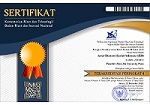Model Perhitungan Biaya Produksi Islami Menggunakan Metode Variable Costing (Studi Kasus Usaha Susu Shi Jeckex Cabang Jogja)
Abstract
Every company is required to run its business very well. The success of a company is very much determined by the accuracy and ability of the leader in managing the company. Production costs are one part of the internal steps that must be taken in increasing efficiency. In Islam there is a classification of costs before calculating production costs because not all funds that come out are calculated as production costs. The company can exercise control over activities that do not add value, which refers to cost control to be effective by applying Variable Coasting methods. Because it is seen from the method of calculation, the variable costing approach is more practical and easy to analyze. The results show that, using a calculation with a variable costing approach, the total production costs are lower than the calculation of real use, which is Rp. 55. 718,000 while using the real calculation, the results are greater, which is Rp. It can be seen that the calculation of the company's real production costs is higher than the calculation of production costs using the variable costing method. There is also the main difference between the real calculation of the company and the calculation of variable costing which is located in the treatment of factory overhead costs. The company's real calculations use fixed factory overhead and variable calculations while the variable costing method only calculates variable overhead costs.
Keywords : Cost, Productions Cost, Variable Costing
Full Text:
PDFReferences
Carter, W. K. 2009. Akuntansi Biaya 1. Jakarta: Salemba Empat.
Elwardi, H. 2014. Cost Accounting dalam Perspektif Syariah. Jurnal Riset Akuntansi dan Bisnis, 188-214.
Garrison, Norren, & Bewer. (2008). Akuntansi Manajeril. Jakarta: Edisi II. Buku 1. Salemba Empat.
Ghufran, A. M. 2002. Fiqih Muamalah Kontekstual. Jakarta: PT. Raja Grafindo Persada.
Hansen, D. R., & Mowen, M. M. 2007. Managerial Accouting. In 8 th edition. Western Australia: Thomson South.
Harahap, S. H. 2011. Analisis Kritis Atas Laporan Keuangan. Jakarta: Raja Grafindo Persada.
Horngren, Harison, & Bamber. 2006. Akuntansi. Klaten: PT. Intan Sejati.
Krismaji, & Aryani A., Y. 2011. Akuntansi Manajemen. Yogyakarta: Unit Penerbit dan Percetakan Sekolah Tinggi Ilmu Manajemen YKPN.
Muhammad. 2002. Pengantar Akuntansi Syariah. Jakarta: Salemba Empat.
Mulyadi. 2010. Akuntansi Biaya. Yogyakarta: Unit Penerbit dan Percetakan Sekolah Tinggi Ilmu Manajemen YKPN.
Oentoe, C. (013. Analisis Perhitungan Biaya Produksi Menggunakan Variable Costing. Jurnal EMBA Vol. 1, No.3, 599-605.
Soeharno. 2007. Ekonomi Manajerial. Yogyakarta: C.V Andi Offset.
Soemarsono. 2009. Akuntansi Suatu Pengantar. In Soemarsono, Akuntansi Suatu Pengantar. Jakarta: Salemba Empat.
Sudarsono. 1995. Pengantar Ekonomi Mikro. Jakarta: PT. Pustaka LP3ES Indonesia.
Supriyono, R. A. 2011. Akuntansi Biaya. Yogyakarta: BPFE.
Surjadi, & Lukman. 2013. Akuntansi Biaya. Jakarta: Penerbit Indeks.
Teguh. 2019, Januari 17. Apakah ada tingkatan jabatan dan perbedaan gaji. (N. Khoirunnisa, Interviewer)
Teguh. 2019, Januari 17. Bagaimana dalam memilih bahan baku. (N. Khoirunnisa, Interviewer)
Teguh. (2019, Januari 217). Sejarah Usaha. (N. Khoirunnisa, Interviewer)
Witjaksono, A. (2006). Akuntansi Biaya. Yogyakarta: Graha Ilmu.
Worotitjan, C. R., & Morassa, J. (2016). Analisis Perhitungan Biaya Produksi Pada PT. Manado Nusantara Informasi (Koran Sindo). Jurnal EMBA Vol. 4, No. 1, 974-981.
DOI: http://dx.doi.org/10.21927/jesi.2019.9(1).9-19

This work is licensed under a Creative Commons Attribution-ShareAlike 4.0 International License.












